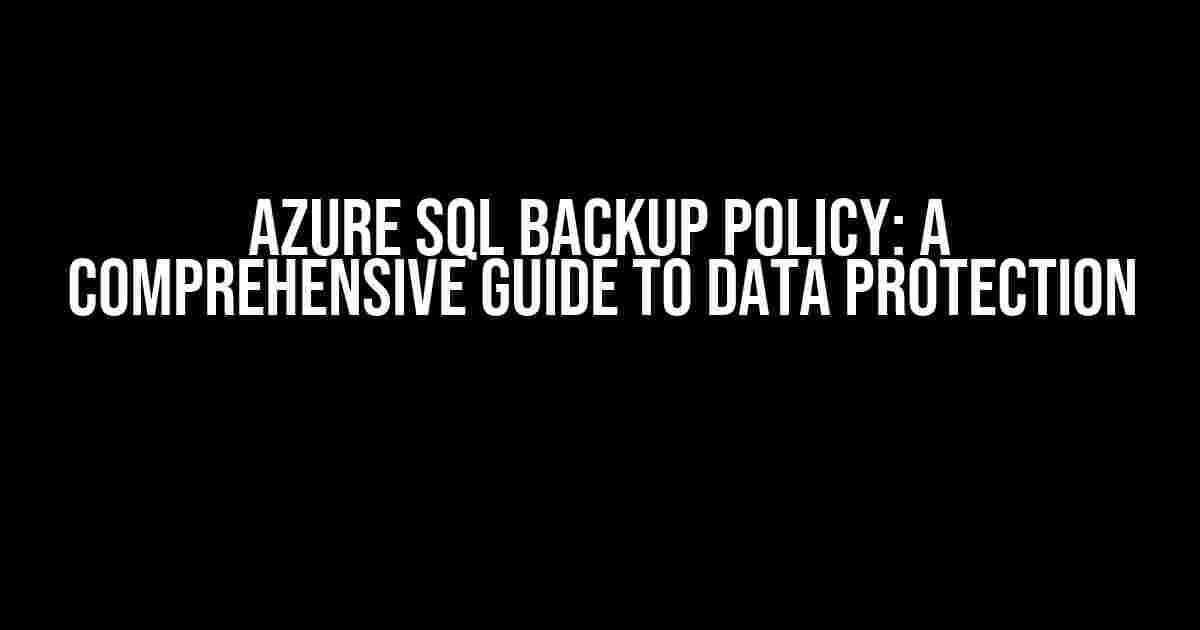Welcome to our in-depth guide on Azure SQL backup policy! As a database administrator, protecting your organization’s data is a top priority. Azure SQL Database provides a robust backup system to ensure your data is safe and easily recoverable in case of an unexpected event. In this article, we’ll explore the ins and outs of Azure SQL backup policy, its benefits, and step-by-step instructions on how to configure and manage it.
What is Azure SQL Backup Policy?
Azure SQL backup policy is a set of rules that define how often and when automatic backups of your Azure SQL Database are taken. This policy ensures that your data is protected and can be restored to a specific point in time in case of data loss or corruption. Azure SQL Database provides two types of backups: automatic backups and long-term retention (LTR) backups.
Automatic Backups
Automatic backups are taken by Azure SQL Database at regular intervals, typically every 10-15 minutes, to capture changes made to your database. These backups are stored in Azure Blob Storage and are retained for a specific period, which can range from 7 to 35 days, depending on your database configuration.
LTR backups, on the other hand, are full backups of your database that are stored for an extended period, typically up to 10 years. These backups are useful for compliance and auditing purposes, as well as for data recovery in case of a catastrophic failure.
Benefits of Azure SQL Backup Policy
Azure SQL backup policy offers several benefits, including:
- Data Protection: Automatic backups ensure that your data is protected from accidental deletion, corruption, or loss.
- Business Continuity: With regular backups, you can quickly recover your database to a specific point in time, minimizing downtime and ensuring business continuity.
- Compliance: LTR backups help you meet regulatory requirements, such as GDPR, HIPAA, and PCI-DSS, by storing backups for an extended period.
- Cost-Effective: Azure SQL backup policy is a cost-effective solution, as you only pay for the storage consumed by your backups.
Configuring Azure SQL Backup Policy
To configure Azure SQL backup policy, follow these steps:
Step 1: Create a Backup Storage Container
Create an Azure Blob Storage container to store your backups. You can create a new container or use an existing one.
az storage container create --name azure-sql-backups --resource-group myresourcegroup
Step 2: Set Up Automatic Backups
Configure automatic backups for your Azure SQL Database:
az sql db update --name mydatabase --resource-group myresourcegroup --backup-storage-uri "https://mystorageaccount.blob.core.windows.net/azure-sql-backups"
Step 3: Configure Long-Term Retention (LTR) Backups
Configure LTR backups for your Azure SQL Database:
az sql db update --name mydatabase --resource-group myresourcegroup --backup-retention-weeks 4 --backup-storage-uri "https://mystorageaccount.blob.core.windows.net/azure-sql-backups"
Step 4: Verify Backup Configuration
Verify that your backup configuration is successful:
az sql db show --name mydatabase --resource-group myresourcegroup --query "backup.storageSettings"
Managing Azure SQL Backup Policy
Once you’ve configured Azure SQL backup policy, it’s essential to manage and monitor your backups regularly. Here are some tips:
Backup Retention Period
Adjust the backup retention period to suit your organization’s needs. You can set the retention period to a maximum of 35 days for automatic backups and up to 10 years for LTR backups.
Backup Storage Cost Estimation
Estimate the storage cost for your backups using the Azure pricing calculator. This will help you plan your budget and optimize your storage usage.
Backup Monitoring
Regularly monitor your backups to ensure they’re completing successfully. You can use Azure Monitor to track backup failures and troubleshoot issues.
Azure SQL Backup Policy Best Practices
Here are some best practices to keep in mind when configuring and managing Azure SQL backup policy:
| Best Practice | Description |
|---|---|
| Regularly Test Backups | Test your backups regularly to ensure they’re recoverable and valid. |
| Use Azure Blob Storage | Use Azure Blob Storage for storing backups, as it provides redundant storage and reduces costs. |
| Configure LTR Backups | Configure LTR backups for long-term data retention and compliance purposes. |
| Monitor Backup Storage | Monitor your backup storage usage and adjust your retention period accordingly. |
Conclusion
Azure SQL backup policy is a robust solution for protecting your organization’s data. By following the steps outlined in this article, you can configure and manage your Azure SQL backup policy to ensure your data is safe and easily recoverable. Remember to regularly monitor and test your backups, and adjust your retention period to suit your organization’s needs. With Azure SQL backup policy, you can rest assured that your data is protected and secure.
By following the best practices outlined in this article, you can optimize your Azure SQL backup policy and ensure business continuity, compliance, and cost-effectiveness. Don’t wait until it’s too late – start protecting your data today!
Frequently Asked Questions
Got questions about Azure SQL backup policy? We’ve got answers!
What is Azure SQL backup policy, and why do I need it?
Azure SQL backup policy is a feature that allows you to automatically back up your Azure SQL databases to Azure Blob Storage. You need it because it provides a safeguard against data loss due to accidental deletion, corruption, or disaster. With automated backups, you can easily restore your database to a previous point in time, ensuring business continuity and minimizing downtime.
How often can I back up my Azure SQL database?
With Azure SQL backup policy, you can configure backups to occur automatically every 15 minutes, hourly, daily, or weekly. You can also specify a specific retention period for your backups, ranging from 7 to 35 days. This flexibility allows you to balance your backup frequency with your storage needs and budget.
Can I customize my Azure SQL backup policy?
Yes, you can! Azure SQL backup policy allows you to customize your backup settings to fit your specific needs. You can choose the backup frequency, retention period, and storage location, as well as specify specific databases or database files to include or exclude from backups. This level of customization gives you control over your backup strategy and helps you optimize your storage costs.
How do I restore my Azure SQL database from a backup?
Restoring your Azure SQL database from a backup is a breeze! Simply navigate to the Azure portal, select the desired backup from the backup history, and click “Restore.” You can then specify the restore point in time, database name, and other settings as needed. Azure will take care of the rest, and your database will be restored to its original state.
What are the benefits of using Azure SQL backup policy?
Using Azure SQL backup policy provides several benefits, including automated backups, flexible retention options, and customizable backup settings. It also ensures business continuity, minimizes downtime, and reduces the risk of data loss. Additionally, Azure SQL backup policy helps you meet compliance requirements and provides a cost-effective solution for data protection.



